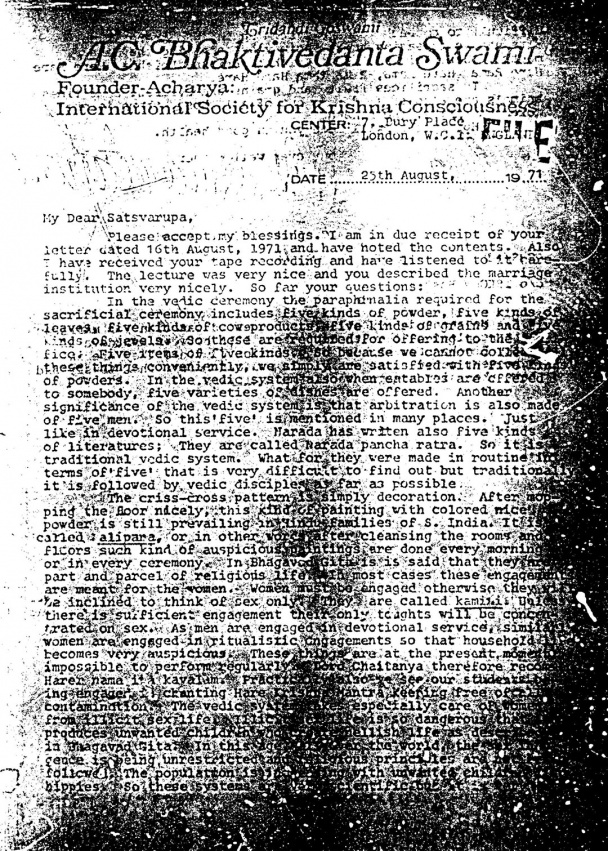710825 - Letter to Satsvarupa written from London

Tridandi Goswami
A.C. Bhaktivedanta Swami
Founder-Acharya:
International Society for Krishna Consciousness
CENTER: 7, Bury Place
London, W.C.1 ENGLAND
DATE ......25th..August,.......19..71.
My Dear Satsvarupa,
Please accept my blessings. I am in due receipt of your letter dated 16th August, 1971 and have noted the contents. Also I have received your tape recording and have listened to the marriage institution very nicely. So far your questions:
In the vedic ceremony the paraphernalia required for the sacrificial ceremony includes five kinds of powder, five kinds of leaves, five kinds of cow products, five kinds of grains and five kinds of jewels. So these are required for offering to the sacrifice: Five items of five kinds. So because we cannot collect all these things conveniently, we simply are satisfied with five kinds of powders. In the vedic system also when eatables are offered to somebody, five varieties of dishes are offered. Another significance of the vedic system is that arbitration is also made of five men. So this "five" is mentioned in many places. Just like in devotional service. Narada has written also five kinds of literatures; They are called Narada pancha ratra. So it is traditional vedic system. What for they were made in routine in terms of "five" that is very difficult to find out but traditionally it is followed by vedic disciples as far as possible.
The criss-cross pattern is simply decoration. After mopping the floor nicely, this kind of painting with colored rice powder is still prevailing in Hindu families of S. India. It is called alipana, or in other words after cleansing the rooms and floors such kind of auspicious paintings are done every morning or in every ceremony. In Bhagavad Gita is is said that they are part and parcel of religious life. In most cases these engagements are meant for the women. Women must be engaged otherwise they will be inclined to think of sex only. They are called kamini. Unless there is sufficient engagement their only thoughts will be concentrated on sex. As men are engaged in devotional service, similarly women are engaged in ritualistic engagements so that household life becomes very auspicious. These things are at the present moment impossible to perform regularly. Lord Chaitanya therefore recommended Harer nama iva kevalam. Practically also we see our students being engaged in chanting Hare Krishna Mantra keeping free of all contamination. The vedic system takes especially care of women from illicit sex life. Illicit sex life is so dangerous that it produces unwanted children who create hellish life as described in Bhagavad Gita. In this age, all over the world, the sex indulgence is being unrestricted and religious principles are not being followed. The population is increasing with unwanted children like hippies. So these systems are very scientific but it is very
[PAGE MISSING]
- 1971 - Letters
- 1971 - Lectures, Conversations and Letters
- 1971-08 - Lectures, Conversations and Letters
- Letters Written from - Europe
- Letters Written from - Europe, England - London
- Lectures, Conversations and Letters - Europe
- Lectures, Conversations and Letters - Europe, England - London
- Satsvarupa - Letters
- Letters Missing Pages or Text
- 1971 - Letters with Scans of the Originals
- 1971 - Letters with Scans of the Originals - checked